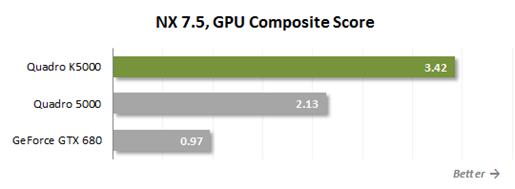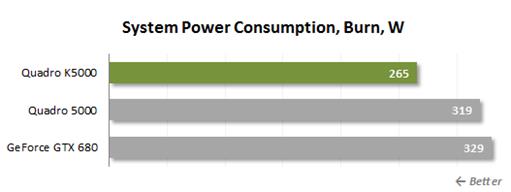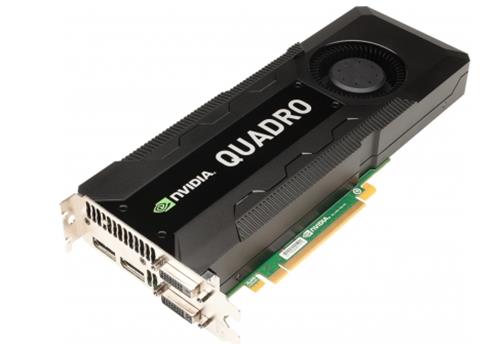PTC
Creo Parametric 2.0
Creo is a popular CAD kit that has replaced
Pro / Engineer. Although based on OpenGL, it runs well enough on both
professional graphics and gaming cards based on Kepler.

Creo
Parametric 2.0, GPU Composite Score
The GeForce GTX 680 is even faster than the
Quadro K5000; apparently it is due to the higher GPU and memory clock rates.
The new Quadro is better than its previous generations based on Fermi. The
difference between them is about 25%.

Creo
Parametric 2.0
If we take a closer look at the results of
Creo Parametric 2.0, we can see that the Kepler architecture takes the biggest
advantage when handling the wireframe models. The Quadro K5000 runs up to 45%
faster than the Quadro 5000.
Autodesk
Maya 2013
The popular 3D graphics editor Maya 2013 is
a typical professional application based on OpenGL API. It does not involve a
particular mini-driver. Everything operates indefectibly through the generic
one.

Maya
2013, GPU Composite Score
The Quadro series driver is certainly be
optimized, making the cards twice as fast as the top-end gaming products with
the most advanced Kepler architecture. Meanwhile, the Quadro K5000 based on
Kepler appears to be not the best selection for Maya. Its previous generations
can offer a little higher performance. The higher overall score of the Quadro
5000 does not mean that this card is better than anything you do with Maya.

Maya
2013
In reality, the Quadro 5000 is just faster
than the Quadro New K5000 when handling 3D models with high quality textures or
shading. If not, the Kepler-based cards are from 8 to 10% faster.
Siemens
PLM NX 7.5
NX is the system's flagship CAD / CAM / CAE
PLM that is widely used in engineering. Therefore, we cannot include it into
our test, especially as the new professional card from Nvidia brings exemplary
performance in that system.

NX
7.5, GPU Composite Score
The Quadro K5000 runs up to 60% faster than
the Quadro 5000 and many times faster gaming card. So, the Quadro K5000 is an
impeccable selection for a workstation running NX.

NX
7.5
The new card is better in every scenario,
but the biggest advantage of operating with semi-transparent models.
Futuremark
3DMark 11
Although the professional graphics cards
are almost never employed for gaming, we still want to run the games for the
popular standard Futuremark 3DMark 2011 to have a look at the graphics cards
from a different angle.

3Dmark
11, Extreme

3Dmark
11, Graphics Score
As you can see, gaming differs from
professional applications. The GeForce GTX 680 runs much faster than the Quadro
K5000, although both are based on the same architecture and even employ the
same GPU. The GeForce GTX 680 only has much higher clock rates, but we couldn’t
talk about its gaming performance. We did not realize that in the professional
applications. Why? It is due to the fact that the application-specific
optimizations can improve the performance of a graphics card in CAD applications
regardless of its hardware capabilities.
Power consumption
In this section, we would like to show you
how much power is necessary for the complete systems (without the monitor)
equipped with the graphics cards tested. We measure the power consumption by
means of the Corsair AX1200i power supply. As a result, it is the sum total of
the consumption of each system component. The performance of PSU does not
affect it.
There are two test modes: idle and high
load (FurMark 1.9.2 running in the Burn mode in a 1280x720 window). We use
FurMark for high load mode, because like most professional applications, it is
based on OpenGL and is really a heavy load.

Systems
consumption, Idle, W

Systems
consumption, Burn, W
The Kepler architecture is an improvement
on the Fermi in energy efficiency, so there is no wonder that the new Quadro
K5000 is much better than its previous generations in this experiment. Although
it is faster in a general view, it saves more power both when idle and high
loads models. In terms of formal specifications, the Quadro K5000 saves more
than 20% compared with the Quadro 5000. And as we can see in reality, replacing
the old card with the new card can help you reduce power consumption of
workstation by an impressive 56 watts.
We should take note that the Quadro K5000
needs less power than the gaming cards that have the same architecture. The
GK104 appears to fit energy saving products if its clock rates and voltage are
not in too high setting mode. Therefore, there is no matter when the Quadro
K5000 has a simpler PCB design than the GeForce GTX 680. The professional card
just does not need more advanced electrical systems.
Conclusion
After establishing their reputation as the
dominant leaders in the professional graphics market a long time ago, Nvidia
does not rest on the glory but still keeps updating regularly oriented
workstation, introducing new graphics architectures and improving the
performance and other parameters. The tested Quadro K5000 card is a good
example of that trend. Replacing the Quadro 5000 models, the new products are
about 35% faster and about 20% more economical, besides a number of other
advantages. The most important thing is that the Quadro K5000 has a typical
price for its class. This makes it become attractive for designers and
engineers who need high graphics processing performance.

Quadro
K5000
Performing well in the gaming cards, the
GK104 chip appears to be impeccable for professional products. Nvidia not only
designed the gaming card successfully, but also optimized it. First, they
changed the energy configuration and clock rate, which explains the high energy
performance of the Quadro K5000. Second, the professional card comes with more
onboard memory, so it can easily deal with complex models and high quality
textures. Third, the driver features CAD / CAM / CAE of the Quadro series are
optimized. And fourth, the Quadro K5000 supports a new version of the Maximus
technology, so it can be employed in conjunction with Tesla computing cards
based Kepler, and is compatible with the Mosaic technology for connecting
multiple monitors to it at the same time.
However, we should suggest some ideas for
Nvidia programmers. They work mainly with how the Quadro K5000 works with the
AutoCAD 2013. For some reasons, they have not upgraded the AutoCAD mini-driver
that supports the AutoCAD 2013, so the Quadro K5000 cannot be shown best in
that common application. It is similar to Creo Parametric 2.0. Hopefully, these
disadvantages will be removed very soon. Finally, appropriate technological
support is what we can expect from the professional graphics cards, and Nvidia
is always careful about completing the drivers to perfect level.
|
The Quadro
K5000 technical specs
·
Architecture: Kepler
·
Chip: GK104
·
Transistor count: 3.5bln.
·
Production process: TSMC 28 nm
·
Streaming processors: 1536
·
Texturing units: 128
·
Raster units (ROPs): 32
·
GPU frequency: 706 MHz
·
Shader domain frequency: 706 MHz
·
Peak performance (single precision): 2150
GFlops
·
Graphics memory frequency: 5.4 GHz GDDR5
·
Memory bus width: 256-bit
·
Graphics memory bandwidth: 173 GB/s
·
Memory size: 4 GBa
·
Maximum power consumption: 122W
|